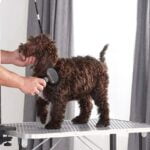Table of Contents
Regular ear cleaning is crucial for maintaining your pet’s health and preventing infections. Learning how to clean your pet’s ears properly can help you keep their ears free from dirt, wax, and bacteria. In this article, we provide 10 essential tips for cleaning your pet’s ears safely and effectively.

Gather Your Supplies to Clean Your Pet’s Ears
Before you start, gather all the necessary supplies: a pet-safe ear cleaner, cotton balls or gauze, and treats to reward your pet. Avoid using cotton swabs, as they can push debris further into the ear canal. For more on ear cleaning supplies, visit PetMD Ear Cleaning Supplies.
Choose the Right Ear Cleaner for Cleaning Your Pet’s Ears
Select a pet-safe ear cleaner recommended by your veterinarian. Avoid using alcohol or hydrogen peroxide, as these can irritate your pet’s ears. For product recommendations, see AKC Best Dog Ear Cleaners.
Get Your Pet Comfortable for Ear Cleaning
Ensure your pet is comfortable and calm before you begin. You may need to have someone help hold your pet if they are anxious. For tips on keeping your pet calm, visit The Spruce Pets Keep Your Pet Calm.
Inspect the Ears Before You Clean Your Pet’s Ears
Inspect your pet’s ears for signs of infection, such as redness, swelling, or a foul odor. If you notice any of these signs, consult your veterinarian before cleaning. For more on ear infections, visit PetMD Ear Infections.
Apply the Ear Cleaner to Your Pet’s Ears
Gently lift your pet’s ear flap and apply the ear cleaner according to the product instructions. Be careful not to insert the applicator too deeply into the ear canal. For detailed instructions, visit ASPCA Ear Care.
Massage the Ear for Effective Cleaning
After applying the cleaner, gently massage the base of your pet’s ear for 20-30 seconds. This helps loosen any debris and allows the cleaner to penetrate deeper into the ear canal. For more on ear massaging techniques, visit PetMD Ear Massage.
Wipe Away Debris After Cleaning Your Pet’s Ears
Using a cotton ball or gauze, gently wipe away any debris and excess cleaner from the outer ear. Avoid pushing debris further into the ear canal. For more on safe ear cleaning, visit AKC How to Clean Dog Ears.
Reward Your Pet After Cleaning Their Ears
After cleaning, reward your pet with treats and praise to create a positive association with ear cleaning. This will make future cleanings easier and less stressful. For more on positive reinforcement, visit Humane Society Positive Training.
Repeat Ear Cleaning Regularly
Regular ear cleaning is essential for preventing infections and maintaining ear health. Consult your veterinarian to determine how often you should clean your pet’s ears based on their specific needs. For more on ear cleaning frequency, visit ASPCA Ear Care.
Know When to See the Vet for Your Pet’s Ears
If your pet shows signs of ear pain, persistent scratching, or continuous head shaking, consult your veterinarian. These could be signs of a more serious issue that requires professional attention. For more on when to see a vet, visit PetMD Ear Issues.
Conclusion
Learning how to clean your pet’s ears is an important part of their overall health and hygiene routine. By following these 10 essential tips, you can ensure your pet’s ears remain clean and free from infections. Regular ear care can help prevent health issues and keep your pet comfortable and happy. For more tips on how to clean your pet’s ears and pet care, check out our Pet Care Guide.
FAQs on How to Clean Your Pet’s Ears
What are the signs that my pet needs an ear cleaning?
Signs include visible dirt or wax, a foul odor, scratching at the ears, and head shaking. Regular inspections can help you determine when cleaning is needed.
What type of ear cleaner should I use?
Use a pet-safe ear cleaner recommended by your veterinarian. Avoid alcohol and hydrogen peroxide, which can irritate your pet’s ears.
How often should I clean my pet’s ears?
The frequency depends on your pet’s breed, ear type, and activity level. Consult your veterinarian for a personalized cleaning schedule.
Can I use cotton swabs to clean my pet’s ears?
No, avoid using cotton swabs as they can push debris further into the ear canal and potentially damage the ear. Use cotton balls or gauze instead.
What should I do if my pet resists ear cleaning?
Keep the experience positive with treats and praise. You may need someone to help hold your pet, or consult a professional groomer or veterinarian for assistance.
What are the signs of an ear infection in pets?
Signs include redness, swelling, discharge, a foul odor, and persistent scratching or head shaking. If you notice these symptoms, consult your veterinarian.











